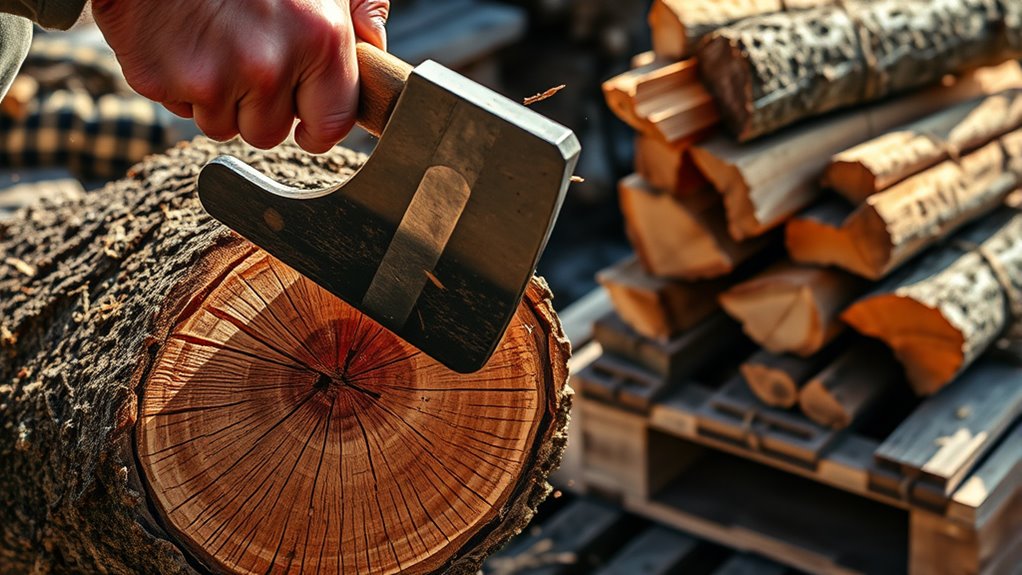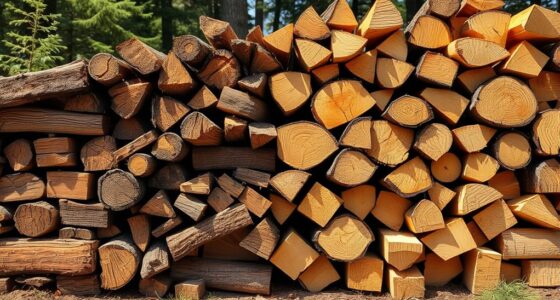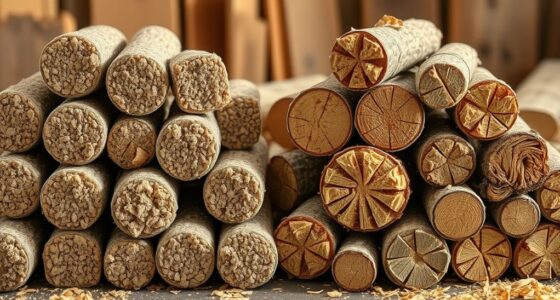To split firewood effectively, use a sturdy splitting axe or maul with a broad wedge, keeping your tools sharp and in good condition for safe and efficient work. Always wear protective gear like gloves, goggles, and steel-toed boots. Position logs on a stable surface and swing with controlled force, aiming at the center to prevent glancing blows. Practicing proper technique helps guarantee safe, quick, and clean splits—keep going to discover more tips for perfect firewood preparation.
Key Takeaways
- Use a splitting axe or maul with a sharp blade for efficient and safe firewood splitting.
- Maintain tools regularly to ensure sharpness and prevent safety hazards during use.
- Position logs on a stable surface and aim for the center of the end grain for accurate splits.
- Keep a proper stance and use controlled swings to reduce injury risk and improve effectiveness.
- Split wood into manageable sizes (16-18 inches) to promote drying, safety, and easier storage.

Splitting firewood is an indispensable step to guarantee your wood burns efficiently and safely. Properly split wood not only enhances combustion but also makes stacking and storage easier. When it comes to seasonal storage, splitting becomes even more paramount because properly prepared wood ensures it dries thoroughly, reducing moisture and improving burn quality. If you neglect this step, you risk storing bulky, unseasoned logs that can trap moisture, leading to inefficient burning, excess smoke, and creosote buildup in your chimney. To make the most of your seasonal storage, you need to split the wood into manageable sizes, typically around 16 to 18 inches long, which is ideal for most fireplaces and wood stoves. This facilitates quicker drying and makes handling safer and more convenient.
Before you start splitting, it’s essential to observe safety precautions. Always wear protective gear, such as safety glasses, gloves, and steel-toed boots, to shield yourself from flying splinters and accidental impacts. Make certain your work area is clear of obstacles, and maintain a stable stance to prevent slips or falls. Keep your tools in good condition—dull axes or splitting mauls require more force and pose a higher risk of glancing blows. Use tools designed specifically for splitting, like a splitting axe or maul, which are heavier and have a broader wedge, making the task more efficient and safer. When swinging, aim accurately at the center of the log’s end grain to reduce the chance of glancing blows that could cause injury or damage the tool.
Using the correct technique is essential. Position the log on a solid, stable surface, such as a splitting stump or a sturdy piece of wood, to prevent it from moving. Hold your tool firmly with both hands, one near the head and the other lower on the handle, and swing with controlled force. Let the weight of the tool do most of the work rather than relying solely on muscle power. For larger logs, make a few initial splits from the ends toward the center; this creates manageable chunks that split more easily. Always inspect the wood for embedded nails or foreign objects before splitting, as striking these can damage your tools and cause dangerous ricochets.
Frequently Asked Questions
How Do I Ensure Safety While Splitting Firewood?
To guarantee safety while splitting firewood, always wear protective gear like goggles, gloves, and sturdy boots. Clear your work area of obstacles and bystanders to create a safe work zone. Keep a firm grip on your axe or maul, and focus on your target. Never rush, and stay alert for any signs of fatigue or mishandling. Following these steps helps prevent accidents and keeps you safe.
What Are the Best Types of Wood for Splitting?
Ever wonder which types of wood are easiest to split? Softwoods like pine, cedar, and poplar have lower wood density, making them ideal for beginners or quick fires. Hardwoods such as oak, hickory, and maple are denser and tougher but burn longer and hotter. Choosing the right types of wood depends on your experience and needs, but softwoods generally require less effort to split and handle.
How Do I Choose the Right Splitting Axe or Maul?
You should choose an axe or maul based on your splitting needs. For handle material, fiberglass offers durability and shock absorption, while wood provides a traditional grip. Consider maul weight options; a heavier maul (around 8-12 pounds) delivers more power for tough logs, but a lighter one (around 6 pounds) offers better control. Pick a tool that feels comfortable and matches your strength for efficient, safe splitting.
What Techniques Help Prevent Wood From Sticking?
Ever wonder how to prevent wood from sticking? You can improve your technique by managing moisture control and blade lubrication. Keep the wood dry, as wet wood is more likely to stick, and apply a light coat of oil or lubricant to your axe blade before splitting. This reduces friction and helps the wood release more easily. Proper technique and maintenance make splitting smoother and more efficient, saving you time and effort.
How Should I Store Split Firewood Properly?
To store split firewood properly, you should prioritize moisture control and seasonal storage. Keep your firewood in a dry, well-ventilated area, ideally off the ground on a rack or pallets to prevent moisture absorption. Cover the top with a tarp, but leave the sides open for airflow. This helps the wood season properly, reduces mold, and guarantees it stays dry and ready for use during the season.
Conclusion
Now that you know the right tools and techniques, splitting firewood becomes easier and safer. Remember, practice makes perfect, and patience pays off. Keep your focus, stay safe, and don’t rush the process. With time, you’ll become more efficient and confident. As the saying goes, “A stitch in time saves nine.” So, take your time, do it right, and enjoy the warmth and satisfaction of a well-split firewood stack.











